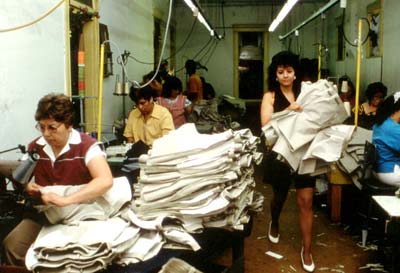Sweatshop Hazards
Risk- probability of a negative consequence
Hazard- a condition with the potential of causing injury to personnel, damage to equipment or structures, loss of material, or lessening ability to perform a prescribed function
Physical Hazards of Sweatshops- Ergonomic Hazards
Factors contributing to physical stress:
- Sitting versus Standing
(commons.wikimedia.org, '10)
Standing
for extended periods, particularly in one place, can produce unsafe levels of
stress on the back, legs, feet.

(justmeans.com, '10)
Sitting
can also be stressful unless the appropriate precautions are taken, including
proper, posture, a supportive back rest, and frequent standing/stretching
movement.
- Stationary versus mobile

(ethicalstyle.com, '09)
Potential
for physical stress increases with stationary jobs when workers fail to take
such precautions as periodically standing/stretching/moving
- Large versus Small Demand for Strength/Power
◦ repeatedly moving small amounts of weight over a period of time can have a cumulative effect equal to the amount of stress generated by moving a few heavy weights
- Good versus Bad Horizontal Work Area
◦ a good horizontal work area does not require the worker to bend forward or twist the body from side to side
- Good versus Bad Vertical Work Area
◦ a good vertical work area does not require the worker to lift their hands above their shoulders or bend down in order to perform any task

(eatdrinkbetter.com, '10)
- Nonrepetitive versus Repetitive Motion
◦ repetition can lead to monotony and boredom
- Low versus High Surface Contact
◦ Contact with hard surfaces such as tools, machines, and equipment tend to be more physically stressful
- Presence versus Absence of Environmental Factors
◦ the
more environmental factors, such as noise or distractions, with which a worker
has to contend on the job, the more stressful the job
Would you eat from this fridge? The chair is keeping this rusty fridge closed (justicia4migrantworkers.org, '06)
Factors contributing to workplace stress:
The National Institute for Occupational Safety and Health (NIOSH) defines job stress as “the harmful physical and emotional responses that occur when the requirements of the job do not match the capabilities, resources or needs of the worker”
- Control
- Most workers experience less stress when they participate in determining the work routine, including schedule and selection of tasks
- Feeling of responsibility
- Bring responsible for the welfare of his or her family may cause a worker to feel that options to take employment risks are limited
- Overly constrained employment options may lead to anxiety and stress
- Job security
- Involves a risk of unemployment
- A worker that believes his or her job is in jeopardy will experience anxiety and stress
- Work schedules
- Unpredictable, never-changing, or ever-changing can induce stress
- Inflexible work schedules do not allow employees to attend to other obligations
- Shift-work that is ever-changing can be stressful
- Ultimately, work schedules can greatly impact the level of control employees have over their lives and the less control they have, the more stress
- Workload demands
- Stress can be stimulated if workload demands are perceived as overwhelming
- Overload refers to an imbalance between a person’s capacity at any given time and the load that person is carrying in a given state
- Lack of environmental safety
- Feeling
that one is in danger can be a stressor

Worker right next to a pile of clothes that could fall over at any second (opednews.com, '10)
Management of Occupational Health and Safety
Organizations that have employees who either speak only limited English or for whom English is a second language must take steps to accommodate their special need in terms of both training and cultural perspectives. Failure to do so can increase the potential for accidents and injuries, as well as lower productivity and higher turnover.